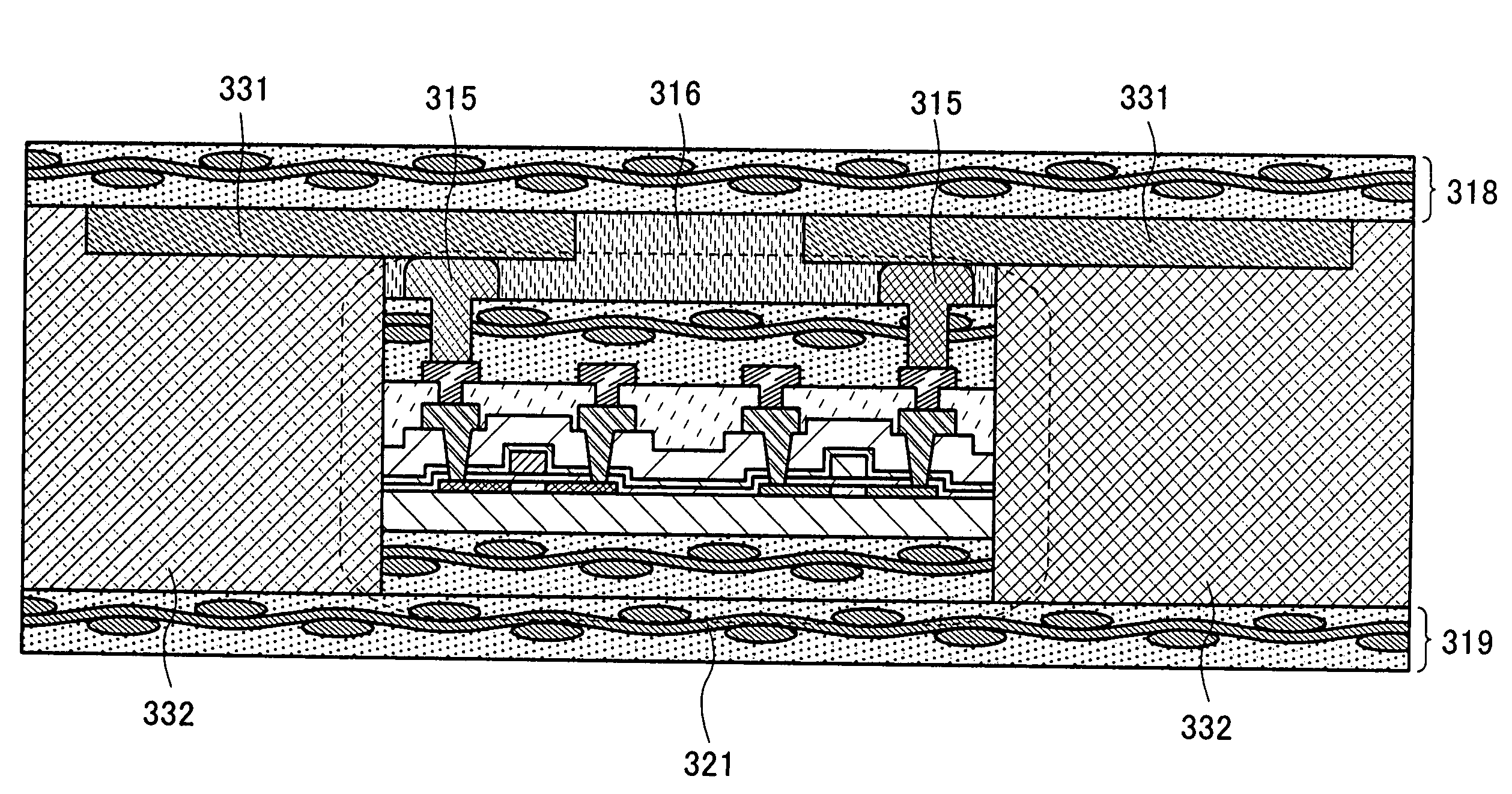Semiconductor device
a technology of semiconductor devices and semiconductors, applied in the field of semiconductor devices, can solve the problems of poor connection, operation defect, and problem of semiconductor device destruction, and achieve the effects of high yield, high reliability, and preventing creases
- Summary
- Abstract
- Description
- Claims
- Application Information
AI Technical Summary
Benefits of technology
Problems solved by technology
Method used
Image
Examples
embodiment mode 1
[0040]This embodiment is described with reference to FIGS. 1A to 1E, FIGS. 2A to 2F, FIGS. 3A to 3D, FIGS. 4A and 4B, FIGS. 5A to 5D, and FIG. 6.
[0041]First, a separation layer 302 is formed over a substrate 301, and then, a semiconductor element layer 303 is formed (see FIG. 1A).
[0042]As the substrate 301, a glass substrate, a quartz substrate, a ceramic substrate, a metal substrate in which an insulating layer is formed on at least one surface, an organic resin substrate, or the like can be used. In this embodiment mode, a glass substrate is used as the glass substrate 301.
[0043]The separation layer 302 is formed having a single-layer structure or a stacked-layer structure of a layer with a thickness of 30 to 200 nm, which is formed using an element selected from tungsten (W), molybdenum (Mo), titanium (Ti), tantalum (Ta), niobium (Nb), nickel (Ni), cobalt (Co), zirconium (Zr), zinc (Zn), ruthenium (Ru), rhodium (Rh), palladium (Pd), osmium (Os), iridium (Ir), or silicon (Si); or ...
embodiment mode 2
[0115]In this embodiment mode, an example in which a sealing layer is formed by a manufacturing method different from that in Embodiment Mode 1 is described with reference to FIGS. 7A to 7D.
[0116]First, the manufacturing steps up to and including the step of formation of the conductive resin 304 (see FIGS. 1A and 1B) are performed based on Embodiment Mode 1. Next, the fiber body 113 is provided over the semiconductor element layer 303 (see FIG. 7A).
[0117]Then, the organic resin layer 114 is formed over the fiber body 113 and the semiconductor element layer 303. At this time, the fiber body 113 is impregnated with an organic resin in the organic resin layer 114. That is, the fiber body 113 is included in the organic resin layer 114. Accordingly, adhesion between the fiber body 113 and the organic resin layer 114 is increased.
[0118]Next, the organic resin layer 114 is heated so that the organic resin in the organic resin layer 114 is plasticized or cured. Note that when the organic re...
embodiment mode 3
[0125]In this embodiment mode, a semiconductor device having a structure different from the structures in Embodiment Modes 1 and 2 is described with reference to FIGS. 8A and 8B.
[0126]FIG. 8A is a cross-sectional view of a semiconductor device in this embodiment mode. FIG. 8B is a top plan view of FIG. 8A. An antenna 331 is provided on the substrate 318, and the chip 321 is attached to the substrate 318 with the adhesive material 316. The conductive adhesive material 315 in the chip 321 is electrically connected to the antenna 331.
[0127]The substrate 318, the antenna 331, and the chip 321 are provided with a base material 332 so as to compensate for the thickness of the chip 321. Accordingly, the thickness of the base material 332 is equal to the thickness of the chip 321, and a flat surface is formed. Moreover, the substrate 319 is attached on the flat surface.
[0128]According to this embodiment mode, a semiconductor device which has a uniform thickness and a flat surface can be obt...
PUM
 Login to View More
Login to View More Abstract
Description
Claims
Application Information
 Login to View More
Login to View More - R&D
- Intellectual Property
- Life Sciences
- Materials
- Tech Scout
- Unparalleled Data Quality
- Higher Quality Content
- 60% Fewer Hallucinations
Browse by: Latest US Patents, China's latest patents, Technical Efficacy Thesaurus, Application Domain, Technology Topic, Popular Technical Reports.
© 2025 PatSnap. All rights reserved.Legal|Privacy policy|Modern Slavery Act Transparency Statement|Sitemap|About US| Contact US: help@patsnap.com



